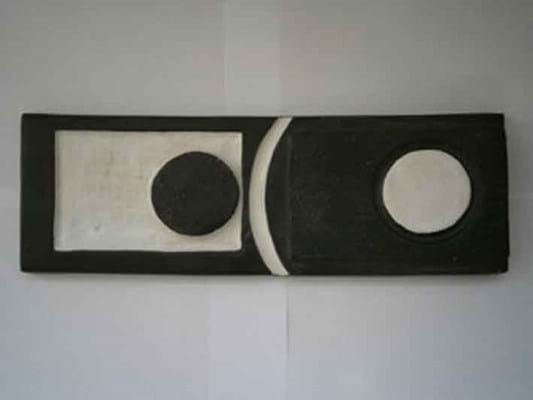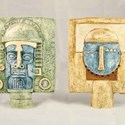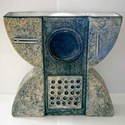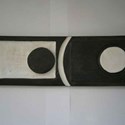Troika 63-83 was launched earlier this year at the Penlee House Gallery & Museum in Penzance, their first exhibition of Troika in 20 years.
The show, running until March 3, was opened by Benny Sirota, one of the three founders of the pottery, and the launch was attended by a number of former Troika employees.
Meanwhile, a new book on the subject has been published to co-incide with the exhibition. Written by Lawrence Illsley, a writer and musician who is the son of another of the pottery's founders Leslie Illsley, and Troika collector Ben Harris, it is also entitledTroika 63-83.
Through the 16 chapters they discuss the unconventional production ideas which came out of the pottery in St Ives and then Newlyn from 1970 - slurry from the local tin mines, household emulsion paint and melted broken glass. After experimentation these produced some extraordinary mould-cast sculptural pieces - tin-glazed wares influenced by Brancusi and Klee, the Cycladic masks with Aztec-style decoration and the heavily-textured monolithic wares that became their trademark.
Born in 1981, Lawrence Illsley was just two years old when the Troika pottery in Cornwall closed after 20 tumultuous years. For him, publishing the new book has been something of a rite of passage.
During the writing of it he learned a great deal about the pottery started in St Ives by his father Leslie Illsley, Benny Sirota and Jan Thompson as they all looked for a new life in the heady artistic surroundings of the Cornish village (Bernard Leach was up the road, Barbara Hepworth round the corner).
Lawrence said: "The best thing about it was meeting all the people who actually knew and in many cases respected my father. It was great that people felt they could be honest with us and speak truthfully about the past, good and bad."
There have been two books on Troika, both out of print, with the first by Carol Cashmore, published in 1994, now fetching £120 upwards from out-of-print book specialists. But this is the first to get inside the story, pulling out the detail and talking to 17 former employees: the casters, fettlers and decorators, with their memories forming the basis of this book.
Troika Story
As is well known, the trio, including sleeping partner Swedish architect Jan Thompson, called their pottery Troika - from Benny's grandfather who escaped from Russia dressed as a woman travelling in a troika, a sledge drawn by three horses. The name appealed too because of the angular forms they had in mind for production.
Benny had an interest in pottery but was the business head of the enterprise, with Leslie the radical and sometimes troubled artist and sculptor.
Right from the beginning the trio had sold to Heals, bouncing up to London in an old van with their designer pots. These found a ready market with young professionals who wanted to dress their homes with a bit of quality and Heals also organised Troika exhibitions in-store and in Sweden.
They continued to supply Heals right through the boom years of the '70s until 1981. It was then all but over for Troika. The book moves inexorably towards the break-up of Benny and Leslie's partnership, described here by Julian Greenwood-Penny, a Troika employee: "Benny was the piece of sand in the oyster that creates the pearl. He was the irritation that got Leslie off his bum. Creativity requires an outlet and Benny was always able to find one. He kept an eye on the wild impulses of his own and Leslie's creations in order to make them palatable to the public."
The last two chapters look at the external and internal factors leading to Troika's demise, when the market was crushed by new, cheap products.
In the early '80s, the predominant factor was price, not quality. "In this light, it is a wonder that Troika survived as long as it did, finally closing in 1983. Troika was not only out of style but out of luck," write Harris and Illsley.
The decline was swift with the Newlyn pottery sold for £21,000 and turned into flats and Leslie, who died in 1989, putting many of the Troika pieces into a skip, including rarities and prototypes.
But the secondary market for this most sculptural of pottery has sparked a renaissance - as Benny, now living in Kent and studying art history, said recently: "It's 50 years since the creation of Troika. I never dreamed, and I'm sure Leslie wouldn't have dreamed either, that it would have had such a long-lasting effect. I only wish Leslie could have been here to see it."
With a timeline and four pages of artists monograms plus 26pp of colour illustrations and some grainy black and white pics (unfortunately printed on rather poor quality paper), Troika 63-83 is published at £25pb. For a copy contact info@troikapedia.co.uk
Dealer's View
Paul Longthorne of the Market House Gallery in Marazion, Penzance, has been a collector of Troika for 12 years and a dealer for 15, trading in the pottery from his gallery for five years and often with some 80 or 90 pieces in stock.
He said: "Over these years there have been peaks and troughs as in many other collecting areas with the strongest designs and colours fetching the highest prices.
"An anvil vase in a plain brown glaze with average design definition might fetch £650 but a striking cobalt blue with tinglazed highlights and strong pattern to both sides could fetch up to £850.
"Popularity of colours tends to be blues, greens and then browns for the textured ware ranges. Particularly rare Troika pieces include whiteware and blackware at £800-2500, masks £600-1200, Celtic crosses £400-600, 14in (35cm) wheel vases £800-1000 and tin mine lampbases £400-£600."
Back around 2004, Mr Longthorne negotiated the £3500 private sale of one of the white glazed sculptural wares that featured in Troika's first exhibition at Heals in 1968.
He collects this rare white/blackware, saying: "Although very difficult to find these days, I feel that these pieces in particular represent Troika at its purest with most designs being cutting edge for the '60s and many were difficult and time consuming to make; many years ahead of their time.
"Many such items would not look out of place on the shelves of current design stores including Ikea."
Mr Longthorne suggests that new collectors could do well to collect a strong and varied collection of both sizes, designs and colours, adding that "the small pieces are always popular irrespective of the general highs and lows in the market at any point in time and subsequently prices are always strong".
He also said the fake market in Troika is thankfully small and most pieces are easily detectable.












